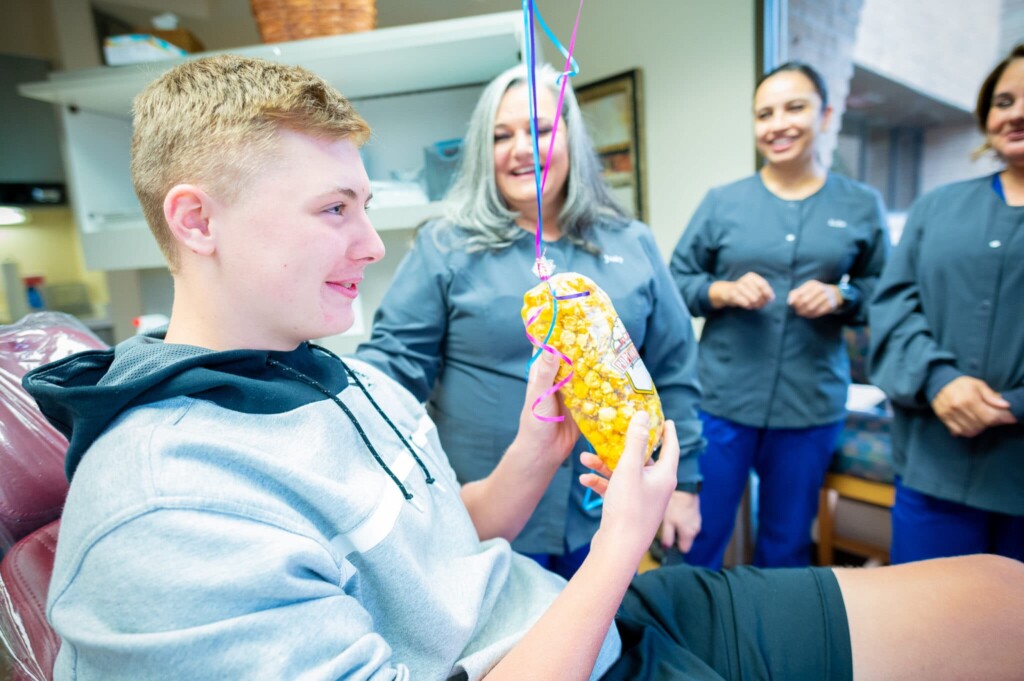Do you know why baby teeth matter? Baby teeth in children serve several important functions beyond being able to learn to chew solid food. They also help a child speak properly and even breathe properly. Baby teeth also allow permanent teeth to come in once they fall out.
What happens if baby teeth are lost early? In some cases, the permanent tooth erupts just fine. In others, the teeth around the space move in, narrowing the space and causing the permanent tooth to erupt incorrectly. Space maintainers for kids can fix this.
Woodhill Dental Specialties wants to do everything possible to ensure your child’s mouth and teeth develop appropriately. If your child loses a tooth early, we can help prevent problems down the road with pediatric space maintainers. Let’s look at what dental spacers for kids are and how they can save your child’s smile.

Space maintainers are devices that keep your child’s teeth in place until the permanent teeth can come in properly. Different types of space maintainers serve different specific purposes, but with the same general purpose of keeping space in your child’s mouth for their permanent teeth.
How long will your child wear a space maintainer? It depends on several factors, including how much your teeth move, how many permanent teeth still need to come in, and how wide your child’s jaw is. We’ll determine an estimated length before we put the device on your child’s teeth.
Are space maintainers necessary? Not in every case, but for those whose permanent teeth alignment is threatened by baby teeth movement, space maintainers have several benefits for children's dental development.
There are three main types of fixed space maintainers for children and a removable type. These pediatric dental appliances hold space in your child’s teeth differently.
This device, commonly called the LLHA, consists of two stainless steel bands that are not removable and wrap around the first molars on the lower teeth. A wire wraps behind the front lower teeth and stretches from the molar on one side to the molar on the other.
The LLHA stops the molars from shifting forward and eating up the space reserved for permanent teeth. It does this without putting pressure on the teeth like braces or retainers. This reduces the chances of teeth crowding, which could require braces treatment later.
The LLHA usually stays on the teeth until most permanent teeth are in, which could mean years. Most children have most of their permanent teeth in by their early teens.

The Nance Arch serves the same purpose as the LLHA, but it’s affixed to the upper molars instead of the lower ones. It’s custom-made to fit your child’s teeth and palate, but it looks slightly different from the LLHA.
Instead of a wire wrapping around the teeth, the wires from the molar bands stretch to the center of the mouth, where an acrylic button lies behind the front teeth to maintain the shape of the upper jaw.
Your child may have speech problems for the first few days, but they should get used to the device fairly quickly.
Unlike an acrylic button like the Nance Arch, the TPA attaches to the molars, and a wire stretches directly between the two bands. The purpose of this device is to maintain the width of your child’s palate so the permanent teeth have plenty of room to erupt.
A TPA can be used independently or as part of a Phase I treatment in Two-Phase braces treatment. A TPA differs from a palate expander, which can also be used in Phase I treatment, in that the TPA doesn’t apply pressure to expand the upper jaw. Instead, it holds the space it has. Two-Phase treatment is often used on children to reduce dental issues and shorten their time in braces later.
This device may resemble an orthodontic retainer or be made to resemble your child’s palate and teeth. You can remove it for eating, brushing, and flossing.
Caring for space maintainers is fairly easy, though it may mean a few changes for your child regarding what they eat. Otherwise, they could damage their devices. It may take your child a few days to get used to the device, but pretty soon, they won’t hardly remember the maintainer is there!
Here are some tips on caring for your space maintainer:

Space maintainers are a strong option to help prevent your child from needing extensive braces treatment later.
Baby teeth play a vital role in holding space for the permanent teeth, but if they fall out too soon or the permanent teeth erupt later than expected, the other teeth can move into the space. This could lead to crooked teeth once they do erupt or even impacted teeth if they don’t come in properly.
Are you concerned about your child’s baby teeth coming out too early? Schedule an appointment with Woodhill Dental Specialties in Dallas, TX, or Rockwall, TX for pediatric dentistry in the Dallas area. We will examine your child and tell you whether a space maintainer is right for them!